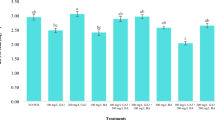Summary
(2-Chloroethyl)trimethylammonium chloride (Cycocel or CCC), an inhibitor of gibberellin biosynthesis, when repeatedly supplied to the root systems of balsam (Impatiens glandulifera Royle) plants reduces growth in height and the level of gibberellin-like substances in the bleeding sap that exudes from the stumps of detopped plants. Within twelve hours after a single application of the inhibitor to decapitated field peas (Pisum arvense), there are quantitative and qualitative changes in the gibberellins of the sap compared with those in sap collected over the same period of time from untreated plants. These changes are interpreted in terms of the possible blockage by CCC of normal gibberellin production and diversion of precursors into synthesis of “abnormal” gibberellins.
Similar content being viewed by others
Literature
Baldev, B., A. Lang, and A. O. Agatep: Gibberellin production in pea seeds developing in excised pods: Effect of growth retardant AMO-1618. Science 147, 155–157 (1965).
Briggs, D. E.: Residues from organic solvents showing gibberellin-like biological activity. Nature (Lond.) 210, 419–421 (1966).
Butcher, D. N.: The presence of gibberellins in excised tomato roots. J. exp. Bot. 14, 272–280 (1963).
Carr, D. J., D. M. Reid, and K. G. M. Skene: The supply of gibberellins from the root to the shoot. Planta (Berl.) 63, 382–392 (1964).
Dennis, D. T., C. D. Upper and C. A. West: An enzymic site of inhibition of gibberellin biosynthesis by AMO-1618 and other plant growth retardants. Plant Physiol. 40, 948–952 (1965).
Greig, J. M., J. S. Pate, and W. Wallace: Techniques for studying physiological rhythms in legume symbiosis. Life Sci. 12, 745–752 (1962).
Grossenbacher, K. A.: Autonomic cycle of rate of exudation in plants. Amer. J. Bot. 26, 107–109 (1939).
Guttridge, C. G.: The interaction of (2-chloroethyl)trimethylammonium chloride and gibberellic acid in strawberry. Physiol. Plantarum (Copenh.) 19, 397–402 (1966).
Halevy, A. M., and S. H. Wittwer: Growth promotion in the Snapdragon by CCC a growth retardant. Naturwissenschaften 11, 310 (1965).
Harada, H., and A. Lang: Effect of some (2-chloroethyl)trimethylammonium chloride analogs and other growth retardants on gibberellin biosynthesis in Fusarium moniliforme. Plant Physiol. 40, 176–183 (1965).
Ikuma, M., and K. V. Thimann: Activity of gibberellin ‘D’ on the germination of photosensitive lettuce seeds. Nature (Lond.) 197, 1313–1314 (1963).
Imamura, S., and Y. Ogawa: Amylase production and growth promotion by gibberellins. U.S.-Japan Seminar on Plant Growth Regulation, Kyoto, Japan, March 1966, p. 99–100.
Kende, H., H. Ninnemann, and A. Lang: Inhibition of giberellic acid biosynthesis in Fusarium moniliforme by AMO-1618 and CCC. Naturwissenschaften 18, 599–600 (1963).
Köhler, D.: Die Wirkung von schwachem Rotlicht und Chlorocholinchlorid auf den Gibberellingehalt normaler Erbsensämlinge und die Ursache der unterschiedlichen Empfindlichkeit von Zwerg- und Normalerbsensämlingen gegen ihr eigenes Gibberellin. Planta (Berl.) 67, 44–54 (1965).
McComb, A. J., and D. J. Carr: Evidence from a dwarf pea bioassay for naturally occurring gibberellins in the growing plant. Nature (Lond.) 181, 1548–1549 (1958).
Murakami, Y.: Bioassay of gibberellins using rice endosperm. Abstracts of the papers, U.S.-Japan Seminar on Plant Growth Regulation, Kyoto, Japan, March 1966, p. 95–98 (1966).
Nicholls, P. B., and L. G. Paleg: A barley endosperm bioassay for gibberellins. Nature (Lond.) 199, 823–824 (1963).
Ninnemann, H., J. A. D. Zeevaart, H. Kende, and A. Lang: The plant growth retardant CCC as an inhibitor of gibberellin biosynthesis in Fusarium monoliforme. Planta (Berl.) 61, 229–235 (1964).
Paleg, L., H. Kende, H. Ninnemann, and A. Lang: Physiological effects of gibberellic acid VIII. Growth retardants on barley endosperm. Plant Physiol. 40, 165–169 (1965).
Pate, J. S. and J. M. Greig: Rhythmic fluctuations in the synthetic activities of the nodulated root of the legume. Plant and Soil. 21, 163–184 (1964).
Phillips, I. D. J., and R. L. Jones: Gibberellin-like activity in bleeding sap of root systems of Helianthus annuus detected by a new dwarf pea epicotyl assay and other methods. Planta (Berl.) 63, 269–278 (1964).
Weaver, R. J., and R. M. Pool: Relation of ringing to gibberellin-like activity in berries of Vitis vinifera L. Nature (Lond.) 206, 318–319 (1965)a.
——: Relation of seededness and ringing to gibberellin-like activities in berries of Vitis vinifera. Plant Physiol. 40, 770–776 (1965)b.
Zeevaart, J. A. D.: Reduction of the gibberellin content of Pharbitis seeds by CCC: after-effects in the progeny. Plant Physiol. 41, 856–862 (1966).
Author information
Authors and Affiliations
Rights and permissions
About this article
Cite this article
Reid, D.M., Carr, D.J. Effects of a dwarfing compound, CCC, on the production and export of gibberellin-like substances by root systems. Planta 73, 1–11 (1967). https://doi.org/10.1007/BF00419836
Received:
Issue Date:
DOI: https://doi.org/10.1007/BF00419836




